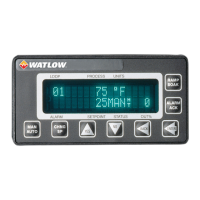CLS200 Series User’s Guide
Chapter 2: Installation
38
Digital Output 1
Digital Output 2
Control Common
+5VDC
Loads
Digital Output 1
Digital Output 2
Using External Power Supply
Do not connect
External
Power
+
-
TB50 or TB18
Using Internal Power Supply
Loads
Supply
TB50 or TB18
to earth ground or
equipment ground
Figure 2.19 — Digital Output Wiring
Configuring Outputs
Keep in mind the following points as you choose outputs for control and alarms:
• You can enable or disable the control outputs. The default setting is heat outputs enabled,
cool outputs disabled.
• You can program each control output individually for on/off, time proportioning, distributed
zero crossing, or Serial DAC control.
• You can individually program each control output for direct or reverse action.
• Alarm outputs other than the global alarm are nonlatching.
• Alarms can be suppressed during process start up and for preprogrammed durations. See
Alarm Delay on page 93.
• Alarm outputs can be configured as a group as normally on (low) or normally off (high). See
Digital Output Polarity on Alarm on page 73.
Control and Alarm Output Connections
Typically control and alarm outputs use external optically isolated solid state relays (SSRs). SSRs
accept a 3 to 32VDC input for control, and some can switch up to 100 Amps at 480VAC. For larger
currents, use silicon control rectifier (SCR) power controllers up to 1000 Amps at 120 to 600VAC.
You can also use SCRs and a Serial DAC for phase-angle fired control.
The 34 control and alarm outputs are open collector outputs referenced to the CLS200’s common.
Each output sinks up to 60mA DC to the controller common when on.

